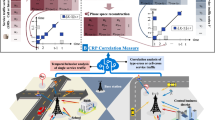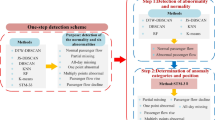Abstract
Big data-driven intelligent transportation plays an important role in smart cities. Moreover, upcoming abnormal events threatening to public safety can be altered prior to their appearance since such events break the regular rhythm of city mobility patterns. The purpose of this study is to detect and forecast abnormal events from the pulse of traffic flows. Specifically, information entropy, Boltzmann entropy, and fractal dimension are used to calculate the degree of the disequilibrium regarding how vehicles distribute on the transportation network. Then, the experiments were conducted based on simulated data and GPS traces of taxies in Shanghai, China. The results show that the proposed method can accurately indicate abnormal events to appear in reality. Finally, a comparison of the advantages and disadvantages of the three chaotic measures leads to insight into the rhythm of city mobility.













Similar content being viewed by others
Explore related subjects
Discover the latest articles, news and stories from top researchers in related subjects.References
Aggarwal CC, Han J, Wang J, Yu PS (2004) A framework for projected clustering of high dimensional data streams. In: Proceedings of the thirtieth international conference on very large data bases, vol 30. VLDB Endowment, pp 852–863
Agovic A, Banerjee A, Ganguly AR, Protopopescu V (2007) Anomaly detection in transportation corridors using manifold embedding. In: Proceedings of the 1st International Workshop on Knowledge Discovery from Sensor Data, pp 435–455
Candia J, González MC, Wang P, Schoenharl T, Madey G, Barabási A-L (2008) Uncovering individual and collective human dynamics from mobile phone records. J Phys A Math Theor 41:224015
Celik SC, Incel OD (2018) Semantic place prediction from crowd-sensed mobile phone data. J Ambient Intell Human Comput 9(6):1–16
Chand S, Aouad G, Dixit VV (2017) Long-range dependence of traffic flow and speed of a motorway: dynamics and correlation with historical incidents transportation research record. J Transport Res Board 2616(1):49–57
Chen S, Wang W, van Zuylen H (2010) A comparison of outlier detection algorithms for ITS data. Expert Syst Appl 37:1169–1178
Chen L, Jakubowicz J, Yang D, Zhang D, Pan G (2017) Fine-grained urban event detection and characterization based on tensor cofactorization. IEEE Trans Hum Mach Syst 47:380–391
Du R, Chen C, Yang B, Lu N, Guan X, Shen X (2015) Effective urban traffic monitoring by vehicular sensor networks. IEEE Trans Veh Technol 64:273–286
Eagle N (2008) Behavioral inference across cultures: using telephones as a cultural lens. IEEE Intell Syst 23:62–64
Eckmann J-P, Moses E, Sergi D (2004) Entropy of dialogues creates coherent structures in e-mail traffic. Proc Natl Acad Sci USA 101:14333–14337
Falconer K (2004) Fractal geometry: mathematical foundations and applications. Wiley, New York
Gasson MN, Kosta E, Royer D, Meints M, Warwick K (2011) Normality mining: privacy implications of behavioral profiles drawn from GPS enabled mobile phones. IEEE Trans Syst Man Cybern C (Appl Rev) 41:251–261
Gonzalez H, Han J, Ouyang Y, Seith S (2011) Multidimensional data mining of traffic anomalies on large-scale road networks. Transport Res Record J Transport Res Board 2215:75–84
Helbing D, Johansson A, Al-Abideen HZ (2007) Dynamics of crowd disasters: an empirical study. Phys Rev E 75:046109
Herrera JC, Work DB, Herring R, Ban XJ, Jacobson Q, Bayen AM (2010) Evaluation of traffic data obtained via GPS-enabled mobile phones: the Mobile century field experiment. Transport Res Part C Emerg Technol 18:568–583
Jiang S, Ferreira J, González MC (2012) Clustering daily patterns of human activities in the city. Data Min Knowl Disc 25:478–510
Li X, Li Z, Han J, Lee J-G (2009) Temporal outlier detection in vehicle traffic data. In: Data engineering, 2009. ICDE’09. IEEE 25th International Conference on, 2009. IEEE, pp 1319–1322
Lu Z, Zhang H, Southworth F, Crittenden J (2016) Fractal dimensions of metropolitan area road networks and the impacts on the urban built environment. Ecol Indicators 70:285–296
Ma X, Chen Y (2014) DDoS detection method based on chaos analysis of network traffic entropy. IEEE Commun Lett 18:114–117
Mahmoud ME-D, El-Araby K (1999) A robust dynamic highway traffic simulation model. Comput Ind Eng 37:189–193
Peng C, Jin X, Wong K-C, Shi M, Liò P (2012) Collective human mobility pattern from taxi trips in urban area. PloS one 7:e34487
Sekimoto Y et al (2016) Real-time people movement estimation in large disasters from several kinds of mobile phone data. In: Proceedings of the 2016 ACM International Joint Conference on Pervasive and Ubiquitous Computing: adjunct, 2016. ACM, pp 1426–1434
Shannon CE (1948) A mathematical theory of communication. Bell Syst Tech J 27:379–423
Stecklov G, Goldstein JR (2004) Terror attacks influence driving behavior in Israel. Proc Natl Acad Sci 101:14551–14556
Sun J, Yuan J, Wang Y, Si H, Shan X (2011) Exploring space–time structure of human mobility in urban space. Phys A Stat Mech Appl 390:929–942
Tellenbach B, Burkhart M, Sornette D, Maillart T (2009) Beyond shannon: characterizing internet traffic with generalized entropy metrics. In: International conference on passive and active network measurement, 2009. Springer, pp 239–248
Wagner A, Plattner B (2005) Entropy based worm and anomaly detection in fast IP networks. In: Enabling technologies: infrastructure for collaborative enterprise, 2005. 14th IEEE International Workshops on, 2005. IEEE, pp 172–177
Wang J-l, H-r Wei, Ye C, Ding Y (2016) Fractal behavior of traffic volume on urban expressway through adaptive fractal analysis. Phys A Stat Mech Appl 443:518–525
Witayangkurn A, Horanont T, Sekimoto Y, Shibasaki R (2013) Anomalous event detection on large-scale GPS data from mobile phones using hidden markov model and cloud platform. In: Proceedings of the 2013 ACM conference on Pervasive and ubiquitous computing adjunct publication, 2013. ACM, pp 1219–1228
Yang S, Liu W (2011) Anomaly detection on collective moving patterns: a hidden markov model based solution. In: Internet of things (iThings/CPSCom), 2011 international conference on and 4th international conference on cyber, physical and social computing, 2011. IEEE, pp 291–296
Yang S, Zhou W (2011) Anomaly detection on collective moving patterns: Manifold learning based analysis of traffic streams. In: Privacy, Security, Risk and Trust (PASSAT) and 2011 IEEE Third Inernational Conference on Social Computing (SocialCom), 2011 IEEE Third International Conference on, 2011. IEEE, pp 704–707
Yang S, Zhang J, Zhang W (2016) Phase-sensitive periodical correlation of local beam descriptors for image registration. Neurocomputing 173:1694–1705
Zhang J, Gao Q, Wang H (2008) SPOT: a system for detecting projected outliers from high-dimensional data streams. In: Data Engineering, 2008. ICDE 2008. IEEE 24th International Conference on, 2008. IEEE, pp 1628–1631
Zhang D, Li N, Zhou Z-H, Chen C, Sun L, Li S (2011) iBAT: detecting anomalous taxi trajectories from GPS traces. In: Proceedings of the 13th international conference on Ubiquitous computing, 2011. ACM, pp 99–108
Zhang X, Yang S, Tang YY, Zhang W (2016) A thermodynamics-inspired feature for anomaly detection on crowd motions in surveillance videos. Multimed Tools Appl 75:8799–8826. https://doi.org/10.1007/s11042-015-3101-8
Zhou W, Yang S (2011) Outlier detection on large-scale collective behaviors. In: Computational Sciences and Optimization (CSO), 2011 Fourth International Joint Conference on, 2011. IEEE, pp 635–639
Acknowledgements
This work is supported by NSFC (Grant nos. 61472087, and 71301096), Shanghai Science and Technology Commission (Grant no. 1751110420), and Shanghai Municipal Natural Science Foundation (Grant no. 13ZR1413400). Daqing Zheng is also supported by funding of SHUFE (no. 2017110433).
Author information
Authors and Affiliations
Corresponding authors
Additional information
Publisher's Note
Springer Nature remains neutral with regard to jurisdictional claims in published maps and institutional affiliations.
Rights and permissions
About this article
Cite this article
Gao, J., Zheng, D. & Yang, S. Sensing the disturbed rhythm of city mobility with chaotic measures: anomaly awareness from traffic flows. J Ambient Intell Human Comput 12, 4347–4362 (2021). https://doi.org/10.1007/s12652-019-01338-7
Received:
Accepted:
Published:
Issue Date:
DOI: https://doi.org/10.1007/s12652-019-01338-7




